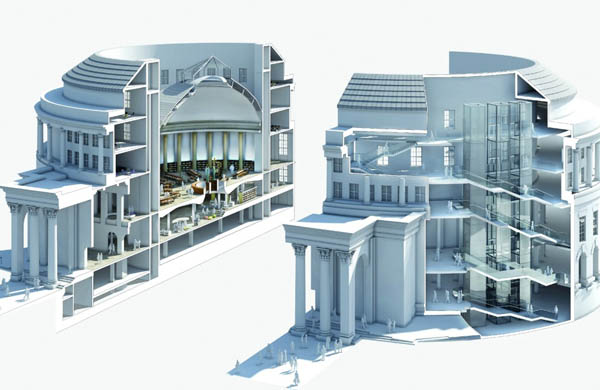The future of construction: Meet BIM (or else)


"Ultimately, we are going to have to work slightly differently."
That's the understatement of the decade, made by a cost consultant working on the renovation of the Central Library in Manchester, England. As reported in Building magazine, the associate from Davis Langdon didn't use BIM -- building information modeling -- like everyone else on the project. Instead, he requested drawings from the architects and marked them up, the old-fashioned way.
In the case of Central Library, as in tens of thousands of other projects worldwide since, BIM was shown to be a pricey retooling that ultimately paid off by shaving time and costs.
Unlike plain-vanilla CAD, BIM software creates a three-dimensional (3D) model full of smart objects embedded with information. BIM makes it easier to integrate architecture with engineering work, avoid "clashes" of building elements, instantly output lists of materials and labor, and automate valuable tasks like simulating the effects of sunlight an interior space.
As for the cost consultant? BIM is about to eat his lunch, I'm afraid.
The fact is, BIM can do much of the estimator's work. In addition to its built-in database about practically every material and product, BIM software can track the cost consequences of every design change in real time -- live, as they say -- and even take the client on a "walkthrough" of the revised design via full-color, 3D animation.
Sound good? In fact, recent changes in the construction kingdom portend a full industry shift to BIM. Soon it will be in every architect's toolbox, as these six key trends suggest:
1. BIM has become national policy.
The British design and building industry is particularly well aware of BIM's big implications, according to expert Phil Bernstein, an architect and technologist with Autodesk, which acquired the BIM platform Revit exactly 11 years ago this month.
"BIM is a central theme in the U.K. government construction strategy designed to reduce carbon and costs as a part of overall economic development," Bernstein said.
Perhaps this should be filed in the "We'll-Try-Anything" category of escaping a deep economic mess. But David Philp, the country's cabinet-level head of BIM implementation, contends that technologies like BIM will render many of today's construction jobs "unrecognizable" by 2050. Another leading Brit, Keith Howells of the big engineering firm Mott Macdonald, equated BIM with the Excel spreadsheet, warning, "If you're not using BIM in five years time, you'll probably be out of business."
2. Like Excel, BIM is good business.
A new analysis from McGraw-Hill Construction, The Business Value of BIM in North America*, shows that BIM adoption in that region expanded from 17 percent in 2007 to 71 percent in 2012, "demonstrating impressive growth despite the recent economic pressures."
It is likely that some contraction in design and build firms helped fatten up those numbers. But still ... don't you wish you had invested in BIM when those housing bubbles popped?
Construction is an international market, of course, and companies such as Graphisoft, Bentley and Autodesk see even faster BIM growth coming in China, Japan and Brazil -- exceeding the 70 percent adoption rate in America.
3. Builders use BIM more than architects.
Here's another strange fact from the McGraw-Hill study: The adoption rate of BIM among builders actually exceeds that of architects.
This phenomenon was first reported last fall, when research showed that 74 percent of contractors roll with BIM, with architects trailing at about 70 percent.
This is important news: Architects will need BIM skills to work with some builders, making it a prerequisite for certain projects. But it also suggests a potential loss of leadership by the design team as contractors take control of "the model" -- for good or for bad.
4. The cloud is BIM's next big thing.
What's next for the technology itself? The shift from desktop to the cloud and mobile will transform BIM and upend the world of architecture once again. Among the changes that you can expect: Cloud computing will support BIM with detailed analytical tools, zapping answers to directly to client meetings and construction sites in real time.
"When BIM data is cloud-based, it becomes accessible for CPU-intensive analytical processes that can leverage the representation to create simulations," Bernstein explained. "Imagine an energy analysis routine running virtually in a parallel with a designer's copy of Revit, giving her real-time feedback on her scheme as it unfolds?"
With that idea in mind, BIM software developer Graphisoft last week released the public beta version of its EcoDesigner STAR, which places energy analysis in the heart of the architect's familiar BIM work environment.
Down the line, projects teams will use smartphones and tablet computers to query huge BIM models -- a "significant shift from traditional desktop-based workflows," Bernstein said. That "likely portends an age where that same information drives computer-controlled fabrication equipment that creates buildings that are assembled, not stick-built."
5. BIM can protect us from superstorms.
For decades, low-bid contracting has been the law of the land, required for all federal and state building projects. With the rise of BIM, Bernstein and others have argued that construction deals can now be based instead on project outcomes.
"With today's building technologies, project teams can simulate the behavior of proposed designs and test digital prototypes for resilience before they are ever constructed,"Bernstein wrote for Fast Company, explaining how BIM could inspire designs that reduce storm-related building damage.
The influence could extend beyond durability and resiliency. Compliance with safety rules, toxicity levels, and even energy regulations could be outcome-based, taking construction contracts to a high level of specificity.
"Architects are taking more and more responsibility for the energy performance of their designs," said Laszlo Vertesi, vice president of development for Graphisoft, in explaining the benefit of EcoDesigner STAR. The product enables architects to use ArchiCAD's BIM directly as a building energy model, or BEM, replete with performance reports to meet the scrutiny of agency officials and green building advocates.
6. Owners might demand it.
I've been hearing this since the advent of BIM technology over a decade ago, but it has never happened. Yet.
Experts such as Patrick MacLeamy, CEO of HOK and chairman of buildingSMART International, point out that top building owners and developers are starting to ask for BIM models as part of their project deals, another factor that is forcing broader adoption.
"Over the next 10 years, building owners will demand ever-increasing usage of BIM as a precondition, ushering in a new era of accuracy, quality and sophistication for the building industry," MacLeamy predicted.
BIM vendors like Vertesi and Bernstein agree. "Mid-term, expect growing engagement by building owners to use models as data assets for facilities management," Bernstein said. "This creates opportunity for designers and builders to provide those datasets as part of the delivery of buildings, and owners an opportunity to use more than old prints of drawings and guesswork to run their valuable assets."
Mental note for that U.K. cost consultant, perhaps?
*Disclosure: I do some freelance writing for McGraw-Hill Construction's continuing education group.
This post was originally published on Smartplanet.com